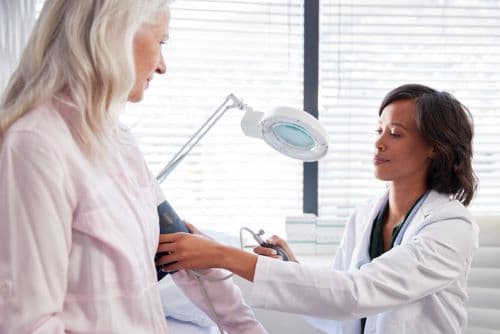Since many health professionals spend their days checking patients’ blood pressure, you’d think they’d be really good at it.
They’re not.
Busy doctor’s offices routinely rush through the tests. This often ends up with patients getting falsely high readings. They are then put on drugs.
The American College of Cardiology has issued guidelines that are supposed to ensure accurate measurements. The problem is that doctors, nurses, and physician assistants are notoriously bad at following them.[1]
Dr. Paul Whelton is a professor at Tulane University. He is on the committee that wrote the guidelines. When blood pressure readings are taken incorrectly, the results can be wildly inaccurate, he said.
“We wouldn’t fly on a plane where the pilot said, ‘I’m going to ignore the guidelines I have for safe travel,’” Dr. Whelton said. “But that’s exactly the situation we have today with respect to blood pressure measurement.”[2]
Blood pressure measurements seem so simple. But you’d be surprised how often professionals get this routine procedure wrong.
A study published in the American Journal of Hypertension looked at blood pressure readings taken by nurses specifically trained to use the correct technique and compared them to those taken by doctors. They found that doctors overestimate blood pressure by an average of about 10 mmHG.[3]
That means that many of their patients are likely taking blood pressure medication that they don’t need.
9 Steps to Getting a Correct Blood Pressure Reading
Here’s how to take blood pressure readings correctly using the guidelines developed by Dr. Whelton and his colleagues at the American College of Cardiology:[4] [5]
- Don’t drink coffee or use nicotine beforehand.
- Make sure your bladder is empty.
- Don’t exercise or eat 30 minutes beforehand.
- Sit in the right position. Sit comfortably with your back supported by a chair. Your legs should not be crossed. Rest your cuffed arm on a flat surface, like a table or chair arm.
- The cuff should be on bare skin, not over clothing. Rolling up a sleeve until it tightens on your arm can result in an inaccurate reading. So you may need to slip your arm out of the sleeve.
- You should be relaxed for at least five full minutes before the test.
- Keep your elbow level with your heart during all the readings.
- Don’t talk while readings are being taken.
- Have your blood pressure taken three times. Wait a full minute between each reading. The average of the three readings is the useful number.
Even if the correct procedures are followed to the letter, you may get a falsely high reading. This is because of a phenomenon called “white coat hypertension.”[6]
It is the result of people being tense or nervous in a healthcare setting. Up to 20% of people with high blood pressure in their doctor’s office don’t have it at home.
This means if you test high during an exam, you should not accept it as the final diagnosis.
You should take readings at home using the steps above. Home blood pressure monitors are widely available at drugstores and online for as little as $30. The top-rated model by Consumer Reports is the Omron Platinum. It retails for $75.[7]
Take readings in the morning and the evening. Do this for at least three days. The average of all the readings should give you an accurate picture of your blood pressure. Only after doing this should you consider taking a blood pressure drug.[8]
4 Natural Ways to Lower Blood Pressure
If you need to take a blood pressure medication, a diuretic should be your first choice. They are an older class of drugs that have a better side effect profile than some of the newer medications.[9]
Better yet, try to lower your blood pressure with any of these four natural methods. They may allow you to avoid taking drugs at all.
Potassium. Most people get too much sodium and not enough potassium. A lack of balance between the two can lead to hypertension.
Doctors often tell people with high blood pressure to cut down on salt to lower their sodium levels. But you can also restore the balance by getting more potassium. Good potassium sources include cooked spinach, cooked broccoli, peas, avocados, watermelon, bananas, tomato sauce, mushrooms, nuts, meat, and poultry.[10]
Saunas. Regular sauna use has been shown to cut high blood pressure risk in half. If you’re not used to saunas, start slow with five- to 10-minute sessions. Once you’re used to it, aim for 15 to 20 minutes, three to five times a week.[11]
Grape seed extract. The seeds have powerful antioxidant properties that lower blood pressure. You can find grape seed extract supplements online and in health food stores.[12]
Berries. One study found that eating a handful of blueberries once a week lowers the risk of high blood pressure by 10%. The active ingredients in berries are anthocyanins. They’re powerful antioxidants abundant in blueberries, raspberries, and blackberries.
One more thing…
If you do take a blood pressure drug, take it before you go to bed.
A recent study looked at data from 19,084 patients. Scientists discovered that people who took blood pressure meds before bed rather than in the morning saw their risk of death from heart or blood vessel problems reduced by 66%. And risk of stroke dropped by 49%.[13]
Editor’s Note: Air Force fighter pilots discovered a simple trick to lower their blood pressure without drugs or strenuous exercise. Read about this surprisingly effective hypertension solution in our monthly journal Independent Healing. It’s your best source for unbiased, evidence-based solutions to the most common health problems.
Related Articles
Coronavirus: What You Should Know About These Blood Pressure Drugs
The Sunshine Solution to High Blood Pressure
Strange Fruit Juice Lowers Blood Pressure
Like this Article? Forward this article here or Share on Facebook.
[1] https://www.peoplespharmacy.com/articles/blood-pressure-measurements-are-too-important-to-leave-to-hospitals?utm_source=The+People%27s+Pharmacy+Newsletter&utm_campaign=e4334f2e54-MC_D_2020-07-02%26subscriber%3D1&utm_medium=email&utm_term=0_7300006d3c-e4334f2e54-221156881&goal=0_7300006d3c-e4334f2e54-221156881&mc_cid=e4334f2e54&mc_eid=d45e3bef7f
[2] https://www.vox.com/science-and-health/2018/7/3/17510132/new-blood-pressure-guidelines-ranges-hypertension
[3] https://academic.oup.com/ajh/article/18/12/1522/204334
[4] https://www.heart.org/en/news/2018/10/05/how-many-at-home-checks-does-it-take-to-diagnose-high-blood-pressure
[5] https://www.mayoclinic.org/diseases-conditions/high-blood-pressure/in-depth/high-blood-pressure/art-20047889
[6] https://www.ahajournals.org/doi/full/10.1161/hypertensionaha.113.01275
[7] https://www.amazon.com/Platinum-Pressure-Bluetooth-Storesup-Readings/dp/B07RX8WQ4K/ref=sr_1_2?dchild=1&gclid=CjwKCAjwi_b3BRAGEiwAemPNUwZ722nXOUAla-leuOyUXR6sF3340WnThiu__Nh9ZUWco0XUd9NT1RoCT5MQAvD_BwE&hvadid=384319453860&hvdev=c&hvlocphy=9012047&hvnetw=g&hvqmt=e&hvrand=15634999859441358962&hvtargid=kwd-822389624574&hydadcr=27087_9993240&keywords=omron+platinum&qid=1593712041&sr=8-2&tag=googhydr-20
[8] https://www.heart.org/en/news/2018/10/05/how-many-at-home-checks-does-it-take-to-diagnose-high-blood-pressure
[9] https://www.webmd.com/hypertension-high-blood-pressure/news/20021217/diuretics-best-for-high-blood-pressure#1
[10] https://www.webmd.com/diet/foods-rich-in-potassium#1
[11] https://www.institutefornaturalhealing.com/2017/11/taking-saunas-can-lower-your-blood-pressure-without-drugs-or-exercise
[12] https://www.institutefornaturalhealing.com/2015/09/this-secret-helps-blood-pressure
[13] https://www.cnn.com/2019/10/22/health/blood-pressure-medicine-at-night/index.html

